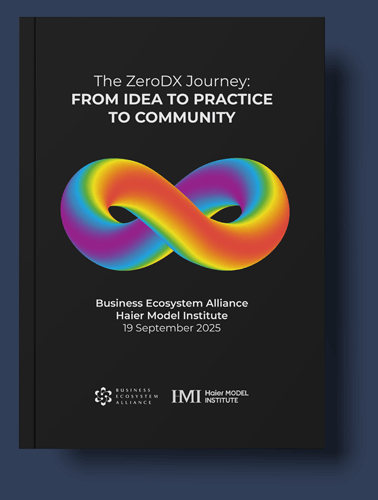Turnstile logic: the new rules of strategy in an ecosystem world
Julian Birkinshaw
The term ecosystem has been used in a business context for 20 years. Companies like Volkswagen and Toyota have been orchestrating huge networks of suppliers and distributors for more than 50 years. Lloyd’s of London, the insurance marketplace, is a classic ecosystem and was founded way back in the seventeenth century. What has changed is that most of today’s fastest growing companies – from Amazon and Google to Alibaba and Tencent to Uber and WeWork – are explicitly positioning themselves as ecosystem players; as hubs within networks of customers, suppliers, and producers of complementary services. Industry observers and regulators are looking on with interest and concern. They want to understand if these companies have developed a new secret sauce, a new way of competing that might challenge the conventional view of how businesses create and capture value.
Of course, the jury is still out on whether these ecosystem players have an enduring advantage. For every Google or Tencent that is hugely profitable, there is a WeWork or an Uber that continues to lose money. It’s important to understand how these firms plan to succeed with their ecosystem strategy – but only time will tell if they are able to realize their ambitions.
The old and new rules of competitive advantage
Warren Buffett is famous for investing in businesses with deep moats. The moat is what protects the business from attackers – sometimes it is based on access to a scarce resource or ownership of a patent, sometimes it is based on customer loyalty and a strong brand, sometimes the moat is an artifact of government regulation.
How do you build a moat? One approach is to position your business skillfully, by finding an industry with high entry barriers and then differentiating your product to keep customers hooked in. The other is to focus on your underlying assets and capabilities: to invest in those assets that are rare, valuable and hard-to-imitate, in ways that competitors cannot match. These two worldviews – the market positioning and the resource-based view – have dominated how we think about competitive advantage for 40 years.
But the rapid growth of business ecosystems in recent years challenges this thinking. Most of these ecosystem “orchestrators” like Google, Alibaba and Uber don’t make and sell things, they exist to link others together; and this makes the old positioning-based logic less relevant. And, of course, they don’t have many assets either, they create value in relationships and networks, not in physical goods or infrastructure; so arguments built around asset ownership are equally challenging. These firms are also looking to grow the market – by increasing the flow of people and goods – rather than capturing as much of the existing market as possible.
In other words, they don’t care much for the moat-based logic of competitive advantage. A more apt metaphor for these firms may be the logic of the turnstile – they want to get as many other players involved in their ecosystem as possible, and to get them interacting according to rules they have shaped. Of course, there are many ways these companies make money – committees, membership fees, advertising sales, and so on – but the key point with all these business models is that they work better when the ecosystem is larger. That’s why the turnstile metaphor is useful.
This shift from moats to turnstiles is challenging to get your head around. For most business strategists, it is second nature to protect their existing assets and to keep competition at bay. But a pure play orchestrator is happy to open up to competition and to share its intellectual property, as long as it keeps the ecosystem growing. Its aim is to maximize the number of people coming through the turnstile, rather than increase the height of the fence or the width of the moat. Let’s consider some examples of how the turnstile logic works in practice.
1. Keep customers flowing in
Most sectors have competing ecosystems – think Android versus iOS – so you need to give people a reason to participate in your ecosystem. Consider WeChat, China’s dominant lifestyle and social networking app. For its first few years, WeChat was all about coming up with novel offerings, such as its Moments and Red Packets features, that drew people in. Once it was established, it could have chosen to monetize its user base through advertising, as Facebook did. But it chose not to: even today, users see only two ads a day, and WeChat makes its money in other ways, primarily commissions on transactions. WeChat prefers to keep the turnstiles moving by emphasizing the quality of its user experience.
2. Give people a reason to stick around
A vibrant ecosystem is one where participants gain value in multiple different ways. WeWork rents out office space to corporations, startups and individuals in prime city locations. It could use moat-based thinking to enforce tight contracts that lock its tenants in. But it prefers to create more flexible contracts that give people the option to leave, and it provides a raft of ancillary services – networking events, advice for startups, lifestyle services – that makes the environment one where people want to stick around.
3. Don’t steal their business
Amazon sells its own products and it also sells third-party products through its marketplace. There is a delicate balance here – and if Amazon pushes its own products too hard, it runs the risk of scaring its third-party vendors away. Consider the alternative case of Alibaba, China’s answer to Amazon as a one-stop shopping destination. Unlike Amazon, Alibaba doesn’t make its own products, and therefore it doesn’t compete with its own suppliers. As its website says, “we operate an ecosystem where all participants have an opportunity to prosper.” Alibaba deliberately passes up some short-term money-making opportunities to help its pursuit of longer-term growth.
4. Keep evolving
One huge benefit of being an ecosystem orchestrator is your privileged access to information about the entire ecosystem. You see what’s selling well, and you see how the market is evolving, before others. While it might be tempting, again, to use this information to make more money in the short term, the smarter approach is to keep things moving – to open up new markets, and to do this quicker than your competitors. Alibaba illustrates this point as well – it keeps coming up with new services, such as Taobao Ke, a traffic aggregation platform, to help it stay ahead. WeWork isn’t standing still either – in recent years it has created WeGrow, WeLive and WeWork Labs.
Ecosystem challenges
This ecosystem-based approach to strategy isn’t for everyone. As a way of working, it is inherently more stressful and chaotic than the more traditional moat-based approach. And it attracts a lot of challenge. For example, critics have suggested that WeWork’s business model is a house of cards. Amazon has fallen foul of regulators for abusing its dominant position. It seems unlikely that Warren Buffett will be putting money into ecosystem businesses any time soon.
And to further complicate things, the split between the worlds of moats and turnstiles isn’t absolute. For example, Amazon isn’t just building an ecosystem – it is also operating in the bricks and mortar world of logistics and retail. Alibaba is explicitly pushing its ecosystem strategy while also building a strong proprietary capability in artificial intelligence. The rules of competitive strategy are not getting any easier. But a good first step is to understand the new turnstile-based logic, and how it differs from the traditional moat-based logic that has been dominating the conversation for the last 40 years.
Julian Birkinshaw is Deputy Dean and Professor of Strategy and Entrepreneurship at London Business School. He is a Thinkers50-ranked thinker. His most recent book is Fast/Forward: Make Your Company Fit for the Future (with Jonas Ridderstråle, 2017).


